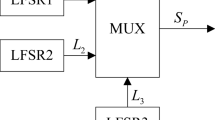Abstract
The article presents the concept of quantum channel compression—decrease in the amount of qubits utilized in a protocol—which is achieved by means of data source encoding. It is also a report on an efficient quantum secure direct communication (QSDC) protocol, which is used for transferring predetermined cryptographic keys (e.g., keys that are generated by the algorithm of Advanced Encryption Standard). This type of quantum secure communication combines the ideas of dense coding process and quantum channel compression. It is justified that such a protocol obtains overall transfer efficiency over unity, i.e., over 100%.



Similar content being viewed by others
References
Bennett, C.H., Wiesner, S.J.: Communication via one- and Two-Particle operators on Einstein-Podolsky-Rosen states. Phys. Rev. Lett. 69, 2881 (1992)
Bostroem, K., Felbinger, T.: Deterministic secure direct communication using entanglement. Phys. Rev. Lett. 89, 187902 (2002)
Cai, Q.Y., Li, B.W.: Deterministic secure communication without using entanglement. Chin. Phys. Lett. 21, 601 (2004)
Long, G.L., Liu, X.S.: Theoretically efficient high-capacity quantum-key-distribution scheme. Phys. Rev. A 65, 032302 (2002)
Deng, F.G., Long, G.L., Liu, X.S.: Two-step quantum direct communication protocol using the Einstein-Podolsky-Rosen pair block. Phys. Rev. A 68, 042317 (2003)
Wang, C., Deng, F., Li, Y., Liu, X., Long, G.: Quantum secure direct communication with high-dimension quantum superdense coding. Phys. Rev. A 71, 044305 (2005)
Deng, F.G., Long, G.L.: Secure direct communication with a quantum one-time pad. Phys. Rev. A 69, 052319 (2004)
Banerjee, A., Pathak, A.: Maximally efficient protocols for direct secure quantum communication. Phys. Lett. A 376, 2944 (2012)
Tsai, C.W., Hsieh, C.R., Hwang, T.: Dense coding using cluster states and its application on deterministic secure quantum communication. Eur. Phys. J. D 61, 783 (2011)
Hassanpour, S., Houshmand, M.: Efficient controlled quantum secure direct communication based on GHZ-like states. QIP 14, 739 (2014)
Joy, D., Surendran, S., Sabir, M.: Efficient deterministic secure quantum communication protocols using multipartite entangled states. QIP 16, 1 (2017)
Yan, F., Zhang, X.: A scheme for secure direct communication using EPR pairs and teleportation. Eur. Phys. J. B. 41, 75 (2004)
Gao, T., Yan, F., Wang, X.: Controlled quantum teleportation and secure direct communication. Chin. Phys. 14, 893 (2005)
Zhu, A., Xia, Y., Fan, Q., Zhang, S.: Secure direct communication based on secret transmitting order of particles. Phys. Rev. A 73, 022338 (2006)
Pathak, A.: Efficient protocols for unidirectional and bidirectional controlled deterministic secure quantum communication: Different alternative approaches. QIP 14, 2195 (2015)
Cao, Z., Li, Y., Peng, J., Chai, G., Zhao, G.: Controlled quantum secure direct communication protocol based on huffman compression coding. Int. J. Theor. Phys. 57, 3632 (2018)
Wilde, M.: Quantum Information Theory, 2nd edn., pp 192–193. Cambridge University Press, New York (2017)
Cabello, A.: Quantum key distribution in the Holevo limit. Phys. Rev. Lett. 85, 5635 (2000)
Kiesel, N., Schmid, C., Weber, U., Toth, G., Guhne, O., Ursin, R., Weinfurter, H.: Experimental analysis of a Four-Qubit photon cluster state. Phys. Rev. Lett. 95, 210502 (2005)
Huffman, D.: A method for the construction of minimum-redundancy codes. Proceeding of the IRE 40, 1098 (1952)
Acknowledgements
The work is supported by the projects  07/10-2016,
07/10-2016,  01/05-2018, and programme YRPD, which are funded by National Science Fund, Ministry of Education and Science, Bulgaria.
01/05-2018, and programme YRPD, which are funded by National Science Fund, Ministry of Education and Science, Bulgaria.
Author information
Authors and Affiliations
Corresponding author
Additional information
Publisher’s Note
Springer Nature remains neutral with regard to jurisdictional claims in published maps and institutional affiliations.
Rights and permissions
About this article
Cite this article
Bebrov, G., Dimova, R. Efficient Quantum Secure Direct Communication Protocol Based on Quantum Channel Compression. Int J Theor Phys 59, 426–435 (2020). https://doi.org/10.1007/s10773-019-04336-9
Received:
Accepted:
Published:
Issue Date:
DOI: https://doi.org/10.1007/s10773-019-04336-9




